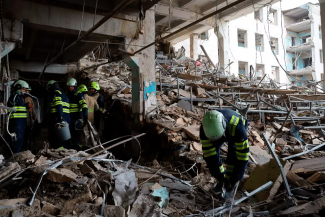Russians shell Poltava. Day 929 of the war

![]()
The introduction of Ukrainian reserves into the fighting in the Pokrovsk area has led to a relative stabilisation of the situation. The defenders are in control of Selydove, but clashes are expected to continue on the eastern edge of that town. According to some sources, fighting has resumed over Hrodivka, a settlement east of Myrnohrad, which was previously occupied by the Russians. After a pause of several days, the Russians launched a new attack in the westerly direction, starting fighting for Lysivka (between Pokrovsk and Selydove). Its seizure by Russian troops would have made it much more difficult to supply the forces defending Selydove and those operating south and east of that town.
The flanking of Ukrainian forces west of Donetsk is extending. Some defenders have retreated, surrendering their last positions in the western part of Krasnohorivka (fighting for this town lasted five months) and the fortified area around the village of Nevelske. The evacuation of the Ukrainian forces is hampered by Russian advances on the west bank of the Vovcha River, where fighting is taking place near the junction villages of Ukrayinsk and Hirnyk, as well as along the Lozova River, which runs parallel. The Ukrainian grouping's path of retreat (its remnants west of Donetsk are estimated at around 3,000 troops) would require them to cross the aforementioned rivers.
The Russians have intensified operations south-west of Donetsk, flanking Vuhledar. After Russia seized Vodyane, which lies to the north, supplying the city is only possible via dirt roads. The situation of the defenders is hampered by Russian advances south of Vuhledar (Russian units have crossed the Kashlahakh River) and west of that city, along the route towards Velyka Novosilka. There, the Russians have taken Prechystivka, from which the road to Kurakhove runs, and have approached Zolota Nyva, from where the road to Pokrovsk runs (both in a northerly direction). Russian forces are also continuing their westward advance from the previously occupied Kostyantynivka junction.
Ukrainian forces briefly recaptured positions in the northern part of Niu-York, allowing the evacuation of soldiers encircled in the area of the chemical plant. Having pushed the Ukrainians out, Russian troops entered Nelipivka, which lies between Niu-York and Toretsk. They also made further advances in Toretsk, occupying more quarters in the eastern part of the city and also west of Niu-York.
Russia is pushing Ukrainian forces out of their last positions east of the Donets-Donbas canal in the Chasiv Yar area. They have crossed the canal north of the town, but have made no significant progress in the town itself. To the north-east of Kupiansk, the Russians captured the ruins of the village of Synkivka, over which fighting had been intermittent since February 2023. They also made further advances south-east of the town towards the Oskil River.
The Ukrainian operational-strategic grouping of Taurida troops confirmed the activation of Russian forces in Kherson Oblast. According to some sources, the Russians have taken several larger islands at the mouth of the Dnipro (Ukrainian troops had previously withdrawn from them) and carried out reconnaissance on its right bank, abandoned in November 2022. Russian artillery and drone activity has also increased. Most likely its main objectives are to tie up Ukrainian forces in Kherson Oblast and to stop further redeployment of subunits from there to the Kursk and Donetsk oblasts.
The front line in Kursk Oblast has stabilised, with limited moves to improve the tactical situation being made by both sides. Ukrainian troops recorded their last minor field advances on 7 September. In an interview with NBC on 5 September, President Volodymyr Zelensky stated that Ukrainian operations in Kursk Oblast had forced the Russians to redeploy around 60,000 troops there, which should be seen as part of the information war. Ukrainian and Western sources estimate the Russian grouping in Kursk Oblast at no more than 30,000 troops. This is thought to be comparable to the forces committed by the Ukrainian side.
![]()
On 3 September, two Russian Iskander-M missiles hit the building of the Poltava Military Communications Institute, now serving as one of the Ukrainian army's training centres. 55 Ukrainian servicemen were killed and 328 injured (there were no reports of civilian casualties). The rescue operation was completed on 5 September, and three more people died in the following days as a result of their injuries. The attack resulted in the highest single confirmed casualty toll (total dead and wounded) since the beginning of the Russian aggression against Ukraine.
Lviv was the target of enemy missiles the following day. Several missiles (including hypersonic Kinzhals) hit the city, and 188 buildings were damaged as a result of falling shrapnel and the shockwave. Local authorities reported seven dead and more than 60 residents injured. An attack using as many as five Iskander-M missiles occurred on 6 September in Pavlohrad, where one person was killed and 82 injured.
Russian kamikaze drones have been destroying power infrastructure in Ukraine’s rear, but also shelling it in the frontline regions. Substations in Kharkiv, Dnipropetrovsk, Donetsk (7 and 9 September) and Sumy (7 and 10 September) oblasts were damaged. A power facility was also hit in Cherkasy Oblast (10 September).
On 5 September, the Ministry of Defence of Belarus reported that several drones had been shot down and had entered the country's airspace (Ukrainian Air Force Command reported one drone flying into Belarus that day). According to Ukrainian data, between the morning of 3 September and the early hours of 10 September, the Russians used 39 missiles (they claimed to have shot down 11) and 295 'Shaheds' (226 shot down).
![]()
On 10 September, Ukraine carried out another massive attack on Russian territory. The Russians reported the destruction of 144 Ukrainian drones, 20 of them over Moscow Oblast and the most – 72 – over Bryansk Oblast. Airfields and fuel-and-energy plants are thought to have been attacked, but there are no reports on the extent of the damage. On 7 September, a Ukrainian UAV destroyed an ammunition depot in Voronezh Oblast. In contrast, a surface drone strike on Novorossiysk carried out on 5 September was unsuccessful.
On 7 September, the Defence Intelligence of Ukraine (HUR) launched a cyberattack on the digital assets of Russian companies working for the defence industry (including the Chelyabinsk plant and the Sibinstrument company in Irkutsk). As a result of the strike, Kyiv allegedly gained access to 14 servers and destroyed internal IT infrastructure by deleting systems files, databases and backups.
On 7 September, the chief of military intelligence Kyrylo Budanov indicated that the Telegram messenger, which is one of the main sources of information for Ukrainian citizens, poses a direct threat to the country's national security. He added that blocking the communicator is technically difficult, but possible.
![]()
On 6 September, with President Zelensky in attendance, the 24th meeting of the Ukraine Defence Contact Group in the Ramstein format took place for the first time since June. The presence of the Ukrainian leader is one element of an effort to convince partners to agree to the use of ballistic missiles (ATACMS) and cruise missiles (Storm Shadow/SCALP) transferred to Kyiv for strikes against Russian territory. Chairing the meeting, US Department of Defense Chief Lloyd Austin confirmed that the US position on the issue remains negative. In doing so, he pointed out that since February 2022, participants in the Contact Group have provided more than $106 billion worth of assistance to Ukraine.
During the meeting, the Pentagon announced a new $250m military aid package. Under the Presidential Drawdown Authority, the following will be transferred from the US military's stores. RIM-7 Sea Sparrow anti-aircraft missiles with additional air defence equipment, Stinger man-portable surface-to-air guided missiles, HIMARS launcher ammunition, 155 mm and 105 mm calibre artillery shells, Javelin and TOW anti-tank guided missiles, AT-4 anti-tank grenade launchers, and Bradley infantry fighting vehicles and M113 armoured personnel carriers (it is expected that there will be around 200 in the latter package).
Promises of further support to Kyiv have also been made by other countries, mostly repeating earlier announcements. By the end of this year, the UK is expected to begin deliveries of 650 LMM (Lightweight Multirole Missiles) worth £162 million ($213 million). In the coming months, 80,840 engines and 1,300 warheads for CRV-7 missiles are due to arrive in Ukraine from Canada, as well as 29 decommissioned M113 transporters and 64 Coyote LAVs for refit or spare parts, and small arms. Spain will donate a battery of the HAWK air defence system (six launchers are already thought to be in Poland), while the Netherlands will provide air-to-air missiles and maintenance material for F-16 fighters (the Dutch have estimated the value of their aid package at €80 million). Germany plans to deliver 12 PzH 2000 self-propelled howitzers (six each in 2024 and 2025) and 77 Leopard 1A5 tanks.
Further announcements of military support for Ukraine also came in the days leading up to and just after the Ramstein meeting. On 3 September, Norway announced the transfer of €48.2 million to the UK-coordinated International Fund for Ukraine (IFU). The funds will be used to purchase drones and air defence equipment. A day later, Chancellor Olaf Scholz confirmed that Germany had ordered 17 IRIS-T air defence systems for Kyiv from its own industry, seven of which have already been delivered. According to an anonymous source in the German government quoted by Bloomberg, Berlin will hand over a total of 24 IRIS-T systems (12 each in SLM and SLS versions) by 2026. On 5 September, President Klaus Iohannis signed a law enabling the delivery of a Romanian Patriot system to Ukraine; the delivery date was not disclosed.
On 8 September, Portugal confirmed the dispatch of six Ka-32 firefighting helicopters to Ukraine, which had already been announced in October 2022. On 9 September, Sweden announced its 17th support package worth €401.6 million. It includes camouflage equipment for previously donated heavy weapons, Pbv 302 tracked transporters, RBS 70 portable anti-aircraft missile sets, anti-tank ammunition, grenade launchers and six CB90 fast landing and assault boats.
On 4 September, Ukraine and Ireland signed an Agreement on Support for Ukraine and Cooperation between Ukraine and Ireland. Unlike previous documents of this type, the use of the phrase 'security cooperation' was dropped from the title. The Irish side confirmed that it supported the supply of non-lethal military equipment with €122 million in 2022–2023. In the current year, this support will amount to €128 million, with at least an additional €40 million for humanitarian assistance. Ireland will also provide demining equipment, cooperate in the cyber security sphere and support the training of Ukrainian soldiers as part of the EUMAM Ukraine mission. Kyiv has so far signed 26 bilateral agreements of this type.
![]()
On 5 September, Commander-in-Chief of the Ukrainian Armed Forces General Oleksandr Syrskyi indicated that the key objectives of the operation in the Kursk raion included stopping the Russians from preparing a new offensive from that direction, drawing Russian forces away from other sections of the front, creating a buffer zone to prevent the Russians from firing artillery into Ukrainian territory in the border area, capturing prisoners of war and boosting the morale of Ukrainian soldiers and the population. He added that Ukrainian forces are weaker in terms of armament and numbers than Russian forces, which have advantages in aviation, missile armament, artillery and ammunition quantities.
Referring to the course of mobilisation, Syrskyi announced that the priority was to recruit more soldiers. At the same time, he acknowledged that conscripts undergo a shortened training cycle (one month of basic military training, followed by a minimum of half a month of specialised training). In his view, delays in US military aid have caused serious setbacks on the battlefield and contributed to a decline in morale. On 6 September, the Ukrainian president announced that Ukrainian forces controlled 1,300 km2 of territory in Kursk Oblast.
![]()
On 8 September, Iranian MP for the Consultative Assembly and member of the Parliamentary Committee on National Security and Foreign Policy Ahmad Bakhshayesh Ardestani confirmed that Tehran supplies ballistic missiles to Russia in addition to Shahed drones. On 9 September, Iran's charge d'affaires Shahriar Amouzegar was summoned to the Ukrainian Foreign Ministry. He was warned that continuing to supply arms to the Russian Federation would cause "irreversible consequences" in bilateral relations.






